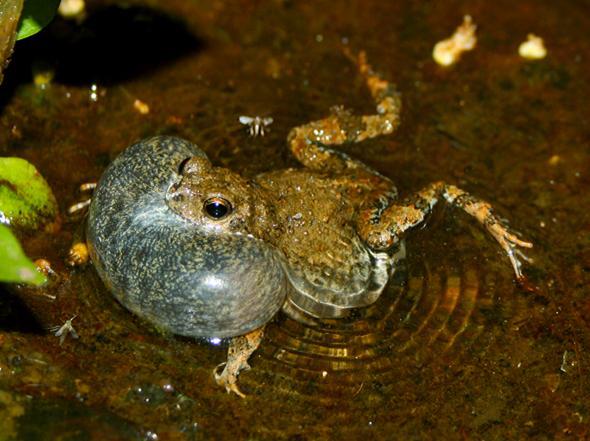“Irrational mate choice” sounds like an accusation my mother might level at me in a terse email subject line, but in this case, it’s the title of a paper on sexual selection in the Panamanian túngara frog (Physalaemus pustulosus) published Thursday in Science magazine. In the paper, behavioral ecologists Amanda M. Lea and Michael J. Ryan report for the first time that female túngara frogs don’t always act rationally when it comes to mating—a finding that could challenge our simple understanding of this kind of mating system.
“This is the first time we’ve found evidence for irrational mating behavior,” says Lea. “If they aren’t making rational decisions, then these models don’t hold up.”
Keep in mind that, in evolutionary biology, rational doesn’t necessarily mean governed by reason (and irrational doesn’t always mean face-palmingly naive). Rather, a rational mating choice is one that conforms to an evolutionary system by which females choose their mate based on his ability to maximize her Darwinian fitness. In the animal kingdom, we expect animals to make these choices as simply, efficiently, and consistently as we choose the best value in off-brand oatmeal.
Yet in the new study, inferior suitors known as decoys—male frogs with a slower call rate*—threw a wrench in the whole “rational system” hypothesis. These decoys snuck into a group of displaying male frogs, thrusting themselves near the better options and throwing off the females’ focus. Weirdly, their presence caused the ladies to switch their initial decisions and instead go for a nearby male with a slower—less appealing—call. Talk about a bad morning after.
One explanation for the switcheroo is that female túngara frogs are easily flustered. (Decoys aren’t the only ones known to have deceived them: “I have to tell you,” says Lea, “I’ve attracted many female frogs making these calls.”) You can hardly blame them. Choosing an amphibious amor is already complex enough, what with all the swelling, foaming, ribbitting, and whatnot. Adding another male to the mix, researchers speculate, could overload the female frog’s cognitive resources and cause her to make a mistake. (This confirms my opinion that grocery stores should only stock one of every option.)
Or the mix-up might be more sinister. Decoys may intentionally create a confusing comparison, taking advantage of the kind of logic used in cognitive tests where people can’t tell that two circles are the same size because of the differently sized circles surrounding them. Similarly, dating is about comparison; the appeal of one prospect changes depending on what’s around him. With the decoy around, the female tends to prefer whatever other male is closest to it—even if he isn’t the most attractive option of the three. Think of him as a particularly ugly wingman: Next to him, the guy sitting next to him suddenly doesn’t look so bad.
“I used to be a bartender, so this is all very familiar,” says Lea, who likes to compare her study species to human males showing off at a bar. A more modern comparison might be the world of online dating, where individuals casually scroll through prospective mates, comparing each one’s profile picture and vital stats to the one that came before it. “If the past 10 are all really really bad, you might just start to lower your threshold,” Lea says.
“I’m actually surprised no one has looked at that,” she adds. “Someone should do that study.”
The inevitable question: What’s in it for the decoy? It could be that he and the other male are engaging in a mutually beneficial friendship, whereby each takes turns acting like an inferior male to give the other a mating boost (frog bros?). In that case, they would probably be genetically related (actual bros!), so that boosting each other’s mating success would also be helping to support their own gene pool. But Lea thinks there is a likelier—and sadder—reason.
Perhaps the decoy has no choice. After all, like the peacock, the túngara frog is a species in which the male’s sole purpose is to mate. True, even if he keeps calling, he’s probably not going to get a mate. But if he doesn’t call at all, then he definitely won’t. So no matter how spindly, how unattractive, or how woefully inadequate he may be, the decoy is doomed to just keep calling, and calling, and calling—even when there’s no one there to answer. “I’ve seen these guys die in the field mid-call,” says Lea sadly. “He’s just doing the best he can.”
Correction, Sept. 8, 2015: Rachel E. Gross originally stated that túngara frog decoys have less appealing voices. Actually, their voices are just as appealing.
